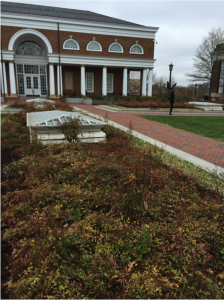Green roofs have become an increasingly popular design feature throughout the US urban landscape. Architects are now adding them onto the roofs of cities in an attempt to encourage sustainability and mitigate environmental impact. The average green roof provides numerous benefits to the surrounding community. Contrary to popular belief, these benefits are not limited the environment. There are three main areas in which green roofs provide major benefits: environmental, economic and social.
Environmental Benefits
One of the primary benefits of green roofs is that it improves the air quality in the surrounding community. Not only does it sequester carbon, but also often becomes a net carbon sink, which is especially useful in an urban setting. A net carbon sink is a reservoir that absorbs more carbon than it releases into the atmosphere. A secondary benefit of green roofs is that they absorb storm water and then absorbed water is filtered and pollutants are removed. Green roofs can also act as a buffer for acid rain, which is especially useful in areas that suffer from reoccurring acid rain. Another benefit of green roofs is that they can be build out of recycled material, which reduces the communal impact on the environment.
Economic Benefits
There are a variety of economic benefits that green roofs provide. One primary benefit is insulation to buildings. Green roofs can keep buildings cooler in the summer and warmer in the winter, thus lowering cooling and heating bills. A second benefit is that if the green roof is properly installed, it can actually lengthen the life of a roof, thus lowering replacement costs. Green roofs also have the opportunity to create jobs through the installation and maintenance of the roof. If there is a garden on the roof, it also offers potential to grow and sell produce. Green roofs and urban agriculture have also been known to increase property value and marketability, which could attract more potential students to look at the University.
Social Benefits
Green roofs are known for creating interactive outdoor spaces and can host spaces for people to relax, converse or study. Green roofs have the potential to foster community through communal upkeep and maintenance. Green roofs provide educational opportunities to schools with the potential for classes based on the biodiversity that the green roofs foster. These roofs also improve productivity, which can be very beneficial to a school community. Green roofs provide numerous mental and health benefits, including reductions in asthma due to improve air quality and a reduction in stress.
Green roofs have the opportunity to provide numerous benefits to the UVA community. While UVA does have some green roofs around grounds, they are unexciting and are not harnessing the potential benefits. Many people worry about the costs of implementing more green roofs around grounds but the average green roof has a payback period of around 6.2 years. Not only does it offer numerous environmental, economic and social benefits but it also will beautify the university and ultimately, pay for itself in benefits.
Ruth Caplin Theater Green Roof
Rouss Robertson Hall Green Roof
Ruth Caplin Theater Green Roof
Rouss Robertson Hall Green Roof
Special Collections Library Green Roof
Post by Morgan Klausner, Second Year, Environmental Thought and Practice Major




